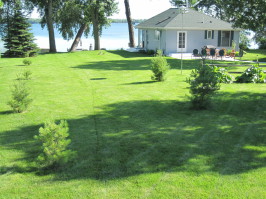
Your Guide To A Lush, Green Lawn
How Often And At What Height Should I Mow My Lawn?
A lawn mowed when necessary and at the right height resists invasions of weeds, insects, and disease, and has a more lush, healthy look. Mowing infrequently, which often results in the removal of too much grass at one time, will eventually produce a lawn with a thin, spotty, or burned out appearance. When cutting your lawn too short, you expose stems that have been shaded and are not adapted to strong sunlight. This can cause the root to die allowing space for more weeds to germinate. As a rule, only 1/3 of the total height of the grass blade should be removed during any mowing to prevent damage. The best practice is to increase the height of the cut as temperatures increase in the summer and reduce it as the temperatures fall. We recommend mowing your lawn at 3 inches.
How Do I Know When My Lawn Needs Watering?
The simplest and most reliable signal is a change in turf color from bright green to a dull blue-green. This color change first occurrs in the most drought-prone spots, especially beneath trees. Water as soon as it's noticed. Another way of checking for water necessity is to take a walk across the lawn. If your grass doesn't spring back after a few seconds, especially in the morning, water is needed. Wait until your lawn shows signs of needing water, then water enough to wet the soil down to the depth of the roots, usually about 6 to 8 inches. An area of 1,000 square feet would take a little less than two hours to water thoroughly. Water about 1 inch per week, increasing the amount to 2 inches in hot weather. Early morning is an ideal time to water, allowing the grass to dry before evening, thus preventing the chance of fungal growth.
Broadleaf Weeds
Annuals - Plants that germinate from seed in the spring, flower, produce seeds and die all within the same season.
Biennials - Plants that grow from seed and develop into a rosette of leaves usually located at or near the ground line during the first growing season. This is the state in which they overwinter followed by flower stalk production the next spring or early summer.
Broadleaf Weeds Are Best Controlled ThroughoutThe Growing Season With Selective Herbicides.
Perennials - Plants that live from year to year surviving primarily by root systems that grow and produce both flower stalks and new vegetative structures each year. Perennial broadleaf weeds represent the largest group of species that cause problems in turf.
Grassy Weeds
Grassy weeds, with their rather narrow, strap-like leaves and parallel veins, are easily distinguished from broadleaf weeds that have many different leaf shapes and leaf veins forming netlike patterns.
Annuals - Germinating in the spring, these grow actively through the summer, produce seed and die within the same growing season. Common ones include Crabgrass, Foxtail, and Sandbur.
Summer Annual Weedy Grasses Are Best Controlled With A Pre-Emergent type of herbicide. This Will Destroy The Newly Germinating Seedling Before It Emerges From The Ground.
Perennials - These survive year to year through plant structures such as crowns, roots, rhizomes, and stolons. Tall Fescue and Quackgrass are the most common perennial grassy weeds.
